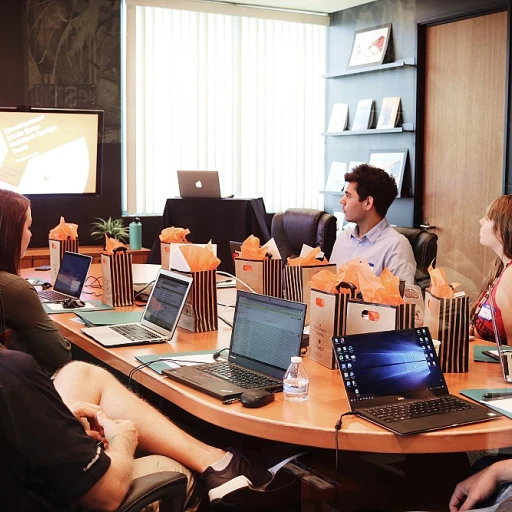
Understanding the Chief Personnel Officer's Role
Redefining the Leadership Paradigm in Human Resources
The role of the Chief Personnel Officer (CPO) has undergone a significant transformation in recent years, evolving from traditional personnel management to a more comprehensive strategic function. As businesses worldwide strive to innovate, the CPO, often synonymous with the Chief Human Resources Officer (CHRO) or Chief People Officer, has become a pivotal figure in driving human resources innovation across organizations.
In many companies, particularly within the United States, the CPO is not merely a manager but a key executive leader, often holding titles such as Vice President of Human Resources or Senior Vice President of Talent Management. This position requires a strategic partnership with other departments, like the financial officer, to align human capital strategies with overall business objectives. It is no longer sufficient for the CPO role to focus solely on routine personnel tasks. Instead, they are charged with enhancing the employee experience and leveraging innovative tactics to attract and retain top talent.
The evolution of the CPO's responsibilities involves fostering a corporate culture that is adaptable to changes, such as remote work, which requires new strategies in technology adoption and workforce engagement. To stay ahead of the curve, companies must emphasize continuous learning and innovation. This commitment to adaptability ensures organizations are prepared to meet future workforce challenges and maintain a competitive edge in talent acquisition and management.
In the modern business environment, the CPO acts as a critical architect of organizational culture, tasked with nurturing an inclusive environment that values diversity. As businesses continue to innovate in human resources, the role of the CPO will only grow in its importance, paving the way for future trends and predictions in HR innovation.
Innovative Strategies in Talent Acquisition
Revolutionizing Employee Recruitment
In the ever-evolving landscape of human resources, the role of a Chief Personnel Officer (CPO) in talent acquisition is critical. Companies are rethinking the way they attract, select, and retain talent, moving beyond traditional methods to embrace innovative strategies that cater to the modern workforce. The objective is not just to fill positions, but to enhance the overall employee experience.Data-Driven Recruitment
An effective CPO role incorporates data-driven decision-making to refine the recruitment process. Utilizing advanced analytics, businesses gain insights into candidate behaviors and industry trends, allowing them to tailor their hiring strategies for optimal results. Analytics enable the prediction of candidate success, making recruitment more efficient and strategic.Establishing a Strong Employer Brand
Building a compelling employer brand is essential for attracting top-notch talent. The CPO and their team must collaborate with marketing departments to craft a brand narrative that communicates the company’s values and culture. This narrative should resonate with prospective employees and differentiate the company from its competitors.Leveraging Technology for Outreach
Technological advancements play a pivotal role in modern recruitment strategies. From AI-driven software that screens resumes to virtual reality tools that offer immersive company tours, technology enhances both the efficiency and appeal of the hiring process. For companies looking to stay competitive, being tech-savvy business executives leading innovation in human resources is crucial.Personalized Candidate Engagement
The personalization of candidate engagement is becoming a significant trend. Potential hires expect a recruitment experience tailored to their needs and preferences. Personalized communication, timely feedback, and interactive platforms for engagement are essential components of a successful talent acquisition strategy. Overall, the innovative strategies in talent acquisition employed by business leaders, including the chief personnel officer, not only boost company growth but also shape a future-ready workforce that can adapt to changing market conditions. The emphasis remains on recruiting individuals who align well with the company's vision while ensuring a seamless and enriching employee experience.Embracing Technology for Workforce Management
Leveraging Technology to Transform Workforce Dynamics
The role of technology in the modern workforce cannot be overstated. It has become pivotal for the Chief Personnel Officer (CPO) in optimizing human resources management efficiently. Embracing digital solutions enables businesses to not only streamline processes but also enhance the overall employee experience. In the past, workforce management often relied on manual systems susceptible to errors and inefficiencies. Today's digital tools empower the CPO role, whether through comprehensive Human Resource Management Systems (HRMS) or innovative talent management solutions. By automating routine tasks, these platforms free up time for strategic decision-making and personalized employee care, essential elements for nurturing a motivated workforce. Integrating analytics and big data is another frontier where CPOs are making strides. Utilized properly, analytics offer invaluable insights into workforce dynamics, enabling human resource leaders to make informed decisions. For instance, analyzing team performance data can reveal patterns and areas for improvement, assisting in tailoring employee development programs. Moreover, with remote work becoming widespread, tools facilitating collaboration and communication have taken precedence. The shift towards remote work necessitates investment in technologies that support connection and management across distances. Leveraging such technologies not only optimizes communication but ensures employees feel valued and a part of the company culture, regardless of physical location. To further explore how the integration of technology into human resources is evolving in these scenarios, consider enhancing HR communication for modern workplaces. This exploration elucidates how open lines of communication foster an engaged and effective workforce. In conclusion, as technology continues to evolve, it remains the cornerstone of successful workforce management. Chief financial officers and other C-suite executives must collaborate closely with CPOs to ensure technological investments align with company goals and enhance the employee experience. Building a future-ready workforce involves not just adopting technology, but embedding it into the core strategies of human capital development.Fostering a Culture of Continuous Learning
Promoting an Environment of Ongoing Development
In the rapidly evolving landscape of human resources, fostering a culture of continuous learning has become a cornerstone in empowering employees and enhancing their overall experience. For Chief Personnel Officers (CPOs), this involves not only advocating for professional growth but also strategically aligning training programs with business objectives. This approach ensures that employee development is not viewed as a standalone activity but integrated into the company's broader goals.
To effectively champion continuous learning, CPOs and other HR leaders such as the Chief Human Resources Officer (CHRO) and Vice Presidents of Human Capital must engage in a collaborative partnership with department heads and executives. This ensures that training initiatives are tailored to meet the evolving needs of the company, especially in sectors where rapid technological changes demand consistent skilling-up of the workforce.
Moreover, adopting innovative strategies in talent acquisition plays a fundamental role. By employing data-driven insights from performance management systems, Chief People Officers can better forecast the skills demand and craft targeted development pathways. This proactive approach helps to close skill gaps, thereby maintaining a competitive edge in the business landscape.
Importantly, the CPO role involves nurturing an environment where learning is part of the organizational culture. This can be achieved through mentoring programs, peer learning opportunities, and the integration of flexible training modules that cater to diversified learning styles among employees. The role of technology cannot be understated in this realm, with e-learning platforms and virtual training sessions providing accessible and scalable solutions.
Ultimately, the Chief Personnel Officer's commitment to continuous learning extends beyond the internal workforce. It involves understanding and navigating external trends, enabling the CPO to shape informed strategies that adapt to changes, such as the implications of diversity and inclusion challenges and technological advancements. The ongoing development of employees reinforces the company's mission and enhances sustainability, anchoring the organization's competitive solidity in the marketplace.
Navigating Diversity and Inclusion Challenges
Addressing Diversity and Inclusion with Innovation
In today's business landscape, the role of the Chief Personnel Officer (CPO) involves not only overseeing talent acquisition and workforce management but also championing diversity and inclusion within the company. It is crucial for the CPO to acknowledge the multifaceted nature of diversity in human resources, extending beyond race and gender to include aspects such as cognitive diversity, age, and life experience. Here are some strategies and insights for navigating these challenges:- Cultivating an Inclusive Culture: Establishing a culture where diverse perspectives are valued is vital. This involves training programs, flexible policies, and encouraging open dialogue among employees and executives. A commitment from the top management, including the chief human resources officer and vice president, greatly enhances the authenticity of these efforts.
- Implementing Data-Driven Practices: Utilizing data analytics to measure diversity metrics can significantly aid in making informed decisions. CPOs can analyze patterns and trends in recruitment, retention, and employee promotions to ensure equitable opportunities are being provided across the organization.
- Promoting Employee Resource Groups (ERGs): ERGs create spaces for employees to connect over shared identities or experiences, providing input to the management team on policies or initiatives. It is essential for the chief personnel officer to support and promote these groups to foster community and belonging.
- Fostering Cross-Departmental Collaboration: Encouraging collaboration across departments allows for cross-pollination of ideas and innovation. This can serve as a strategic advantage in problem-solving and enhances the company’s collective capability to innovate.
Future Trends and Predictions in HR Innovation
Anticipating the Future of HR Innovation
The landscape of human resources is rapidly evolving, with the role of the Chief Personnel Officer (CPO) becoming increasingly pivotal. As companies navigate the complexities of modern business, the CPO's role is expanding beyond traditional boundaries, demanding a forward-thinking approach to human capital management.
Integrating AI and Machine Learning
Artificial intelligence and machine learning are set to revolutionize the way companies manage their workforce. These technologies can streamline talent acquisition, enhance employee experience, and provide data-driven insights for strategic decision-making. As highlighted in earlier sections, embracing technology is crucial for effective workforce management, and the CPO must lead this digital transformation.
Prioritizing Employee Well-being
Future trends indicate a growing emphasis on employee well-being as a core component of HR strategy. Companies are recognizing that a healthy, engaged workforce is essential for sustained business success. The CPO, along with other senior executives, will need to champion initiatives that promote mental health, work-life balance, and overall employee satisfaction.
Enhancing Diversity and Inclusion
As discussed in the context of navigating diversity and inclusion challenges, creating a diverse and inclusive workplace remains a top priority. Future HR innovations will likely focus on developing more effective strategies to foster an inclusive culture, ensuring that all employees feel valued and empowered to contribute to the company's success.
Adapting to Remote and Hybrid Work Models
The shift towards remote and hybrid work models is another trend that will shape the future of HR. The CPO will play a critical role in developing policies and practices that support flexible work arrangements while maintaining productivity and engagement. This requires a nuanced understanding of employee needs and the ability to implement innovative solutions that align with business objectives.
Conclusion
The future of HR innovation is both exciting and challenging, with the CPO at the forefront of driving change. By staying ahead of emerging trends and leveraging new technologies, companies can create a dynamic and resilient workforce that is well-equipped to meet the demands of the modern business environment.












